Mission type Technology COSPAR ID 2013-009B Mission duration 6 months planned Inclination 98.62° Launch mass 1,000 g Launch date 25 February 2013 | Operator Aalborg University SATCAT № 39087 Inclination 98.62° Period 1.7 hours Launch mass 1,000 g | |
 | ||
Website www.space.aau.dk/aausat3 Similar Sapphire, STRaND‑1, Near Earth Object Surveilla, Drag and Atmospheric Neutral D, USA‑243 | ||
Bexus 09 launch video flying aausat3 navis cubesat among other
AAUSAT3 is the third CubeSat built and operated by students from Aalborg University in Denmark. It was launched on 25 February 2013 from Satish Dhawan Space Centre in India on a PSLV rocket (no C20). AAUSAT3 carries two AIS receivers as the main payload.
Contents
- Bexus 09 launch video flying aausat3 navis cubesat among other
- The educational objective
- The scientific objective
- History
- Operations
- Satellite Subsystem Strategy
- HAM information
- References
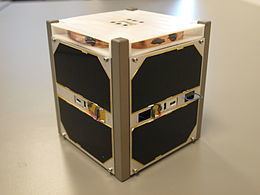
AAUSAT3 is made solely by students.
The educational objective
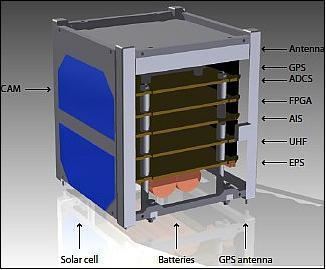
The primary purpose of construction of satellites at Aalborg University is to give the students engineering capabilities beyond what is normally achieved within a masters program. All design, implementation and manufacturing has been carried out by students with two exceptions: Manufacturing of mechanical structure (carried out by department workshop in alu7075) and the raw non-mounted PCBs.
The scientific objective
To answer the question - Is it possible to receive AIS signals from a 1U cubesat ?
History
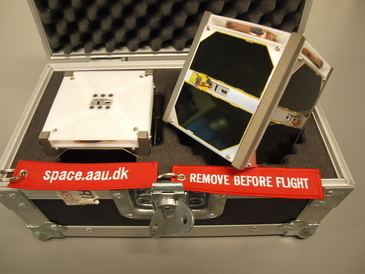
Student satellite activities at Aalborg University (AAU) started in 2003 as a result of AAU's involvement in the first pure Danish research satellite, Ørsted, which was successfully launched in 1999.
AAUSAT3's predecessor was
Students from AAU did also participate in SSETI EXPRESS(launched 2005) - a student satellite initiative from ESA Education,
The construction of AAUSAT3 began in 2007.
Operations
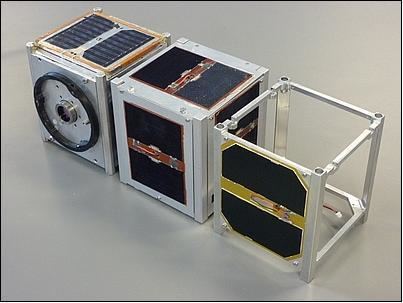
AAUSAT3 was launched 25 February 2013 on PSLV C20. As the time of writing operations has been a very huge success. 9000 AIS messages are received on daily basis and downloaded to the MCC located in Aalborg Denmark. All sub systems has been tested and are running.
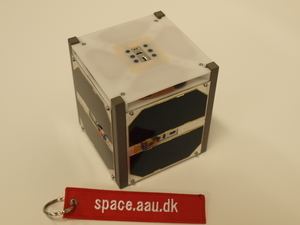
The first 100 days of operation has been very successful. No degradation of the satellite has been observed, all sub systems are working and the primary payload - an AIS receiver - is working correctly. The mission will continue until further notice.
Two critical situations has taken place during the first 100 days:
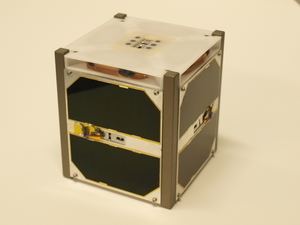
28. February 2013 06:08 the very last beacon for some days was received. During the last 24 hours battery voltage was decreasing and temperature readings did indicate that AAUSAT3 was steady pointing the sixth side without solar cells towards the sun. The last passes over Aalborg it was observed that battery voltage was slowly decreasing.
The situation was discussed and analysed during the day and it was decided to instruct AAUSAT3 on all upcoming passes to switch off beacon mode because it was using power (radio).
No further attempt was taken to gain contact during the weekend because if very slow charging was taken place it should have peace to regain to normal mode. All passes was supervised.
There were total silence until 4. March 17:52 where the ground station in Aalborg did request and did receive a beacon. The beacon did show an up-time of 1 day 19 hours and that everything was working ok and more than 7000 AIS messages received. Everything went back to normal. The requested beacon did also show a high number of reboots - which we think was due to low battery voltage.
Due to this event AAUSAT3 is now by intention set to tumble very slow - 2 rotations for every orbit (approx 100 minutes) - to avoid a repetition of the situation.
24. May 2013 the power system (EPS) onboard AAUSAT3 rejected to handle multi frame communication packages from ground. During 4 passes (500 minutes) the students did analyze the situation and inspected the C source for the EPS server and a solution was found. One proper crafted package was sent to AAUSAT3 and normal situation for the EPS was re established. During the event the rest of the satellite was - due to the decentralised design - working perfect. The team expect a bit flip to be the case.
During the first 100 days close to 800.000 AIS packages has been received and downloaded.
10-11. Juni 2013 two new SW images for the SDR AIS receiver(AIS2) was uploaded without problems. It takes approx 1.5 path to upload a full AIS receiver.
It has shown real improvement and is now capable to sample and decode in real time. First metrics shows a capacity around 6000 AIS messages/hour in average.
25. February 2014 One year up in space. AAUSAT3 is fully functioning and AIS measurements are done on a regular basis. There has been established a ground station at Thule - Greenland for extended download capacity. Energy production is now stable but rather low stable, so the mission are interleaved with hours or days for charging batteries. New uploaded algorithms now shows reception of approx 8000 messages/hour and real time performance which means that decoding takes less time than sampling and is carried out in parallel. Due to the ground station at Thule it is possible to carry out real time supervision around Greenland: measuring and downloading at same time. So only a few seconds after detection the information is available i Aalborg at our MCC.
The mission continues.
See [1] for more information
Satellite Subsystem Strategy
AAUSAT3 is based on a non centralized concept with no dedicated master. The idea behind this approach is to achieve a modular satellite which in many cases will be able to function even when certain subsystems fail. For that reason the must-have subsystem (EPS and COM) are by purpose designed simple and very robust whereas subsystems like AIS2 are quite more complex and therefore must be a design of higher complexity and nature then have a higher failure rate.
The power system(EPS) acts as intelligent supervisor and watchdog. AAUSAT3 consists of several sub-systems:
On the ground segment there is:
All internal and satellite to ground station is carried out using CSP protocol which is a spin of AAUSAT3.
